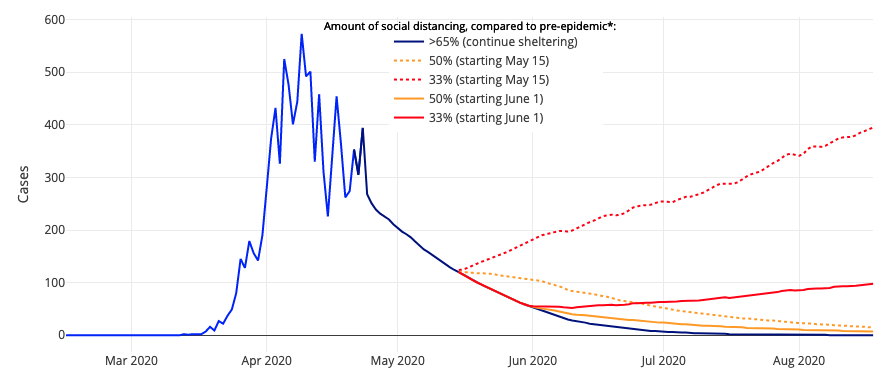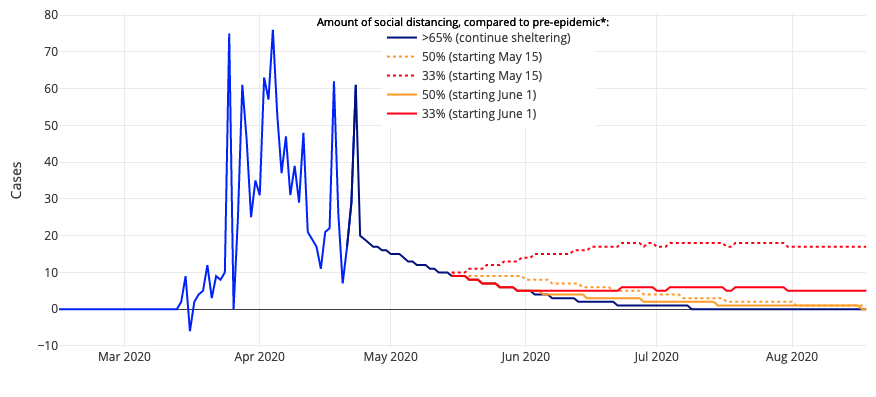Modeling COVID-19: The Local Effect of Weather & Cautious Reopening
As we enter May, a new phase in the COVID-19 pandemic begins, one in which we will shift as a nation from response to recovery. To coincide, our team at PolicyLab released today our updated forecasts for COVID-19 cases across 211 U.S. counties to support leaders throughout the country as they prepare to reopen their communities.
Our team began this project because of our commitment to the children and families we care for each day. They have not only had to respond to the risk of COVID-19 infection in their own families, but have also faced challenges of continued employment, school closures and, for many, the loss of income and their livelihoods.
Our intention as we continue to update our models, known as COVID-Lab: Mapping COVID-19 in Your Community, is to provide rigorous predictions that can inform the reopening of communities for our families and a return to school for their children. But we are mindful of the need to do this safely, as we weigh the risks of COVID-19 infection against the risks that have quickly accumulated from the closing of society. We ask you to remember these are forecasts, and we will update them as actual distancing behavior and weather changes occur in the weeks ahead. They are best viewed in terms of their relative interpretations: how much to be cautious, how slowly to go. The absolute numbers may change, but the overall insights will not.
In our updated models, we again revisit the scenario in which counties would reopen on May 15. In contrast to the original models we released last week, we now consider two fixed assumptions of what activity will return to when an area reopens: a conservative estimate that members of the community will visit non-essential businesses half as much as they did in February, before the epidemic, and a riskier scenario in which individuals’ activity will only be reduced by 33% from what they were doing in February. We also illustrate what waiting until June 1 to implement these changes could mean for a county. Here are just two examples:

Above are the projections for Philadelphia County.

Above are the projections for Allegheny County.
Our results reveal that, in general, large, densely populated communities do better by reopening slowly and cautiously. At the same time, we would encourage you to check out your own county, as some continue to have high enough transmission, where the margin for error is lower.
These updated models differ from the earlier versions in that we are detecting stronger effects of higher temperatures as we move further into spring. That is good news. However, the effect of higher temperatures continues to have some degree of uncertainty. Within our range of spring temperatures, we are likely observing two main competing forces on viral transmission: the direct influence of temperature on reducing aerosolized transmission of the virus and the likelihood that social gathering behavior within communities increases, particularly the desire to go outdoors and be with friends. (We call that the Mardi Gras effect.)
We will need data that includes summer temperatures to be more certain of the potential benefit of higher temperatures in reducing transmission. To the degree that people remain cautious, we hope it will allow the warming temperatures to have maximum benefit in reducing viral transmission. High humidity remains the X factor; more on that once those hazy days arrive. The Memorial Day barbecue will go on, but perhaps it should be smaller and more intimate.
We will take some good news when we can. The increasing influence of warming temperatures has downgraded our forecast for a second large peak of cases in many locations. However, we would caution that by itself, higher temperatures are unlikely to be enough to substantially decrease community transmission. Social distancing remains the most important factor, as does the number of cases a community has when they decide to reopen, and the proximity of their reproduction number (R) to a value of 1. (For every COVID-19 case, R estimates the number of additional individuals infected.) If their R has not degraded well below 1 when they reopen, their risk for continued or elevated transmission is higher in this forecast.
We would also caution against complacency in communities that have better forecasts. The contagiousness of the virus means that the risk for a nursing home outbreak or spread among a group of workers in a factory or meatpacking plant remains high, whether in a rural or urban location. Practices that decrease transmission that are not accounted for in our models, such as masking and maintaining physical distance, remain an important part of the strategy to prevent future outbreaks. And we should be mindful that the long game is to have as few cases as possible going into fall when temperatures start to decline again.
So, what’s next for the COVID-Lab modeling project? We look forward to replacing our forecasts with more real-time data. As communities make different choices in the weeks ahead, we will shift from long-range forecasts to monitoring individual communities for their risk for resurgence in a shorter time window. We recognize that decisions will be made more frequently, from which the horizon for surveillance will be the next 2-4 weeks, and not the whole summer. We also look forward to incorporating emerging serology data into our estimates. In places like New York City, seroprevalence rates may have reached 20%. If it turns out that immunity is conferred by infection, that community-wide immunity will likely help reduce transmission risk for those areas in the months ahead.
Thanks for visiting our site, and for taking this journey with us. We look forward to sharing our work over the weeks ahead.
Gregory Tasian, MD, MSc, MSCE, is an associate professor of urology and epidemiology and a senior scholar in the Center for Clinical Epidemiology and Biostatistics at the University of Pennsylvania Perelman School of Medicine. He is also an attending pediatric urologist in the Division of Urology at Children's Hospital of Philadelphia.

